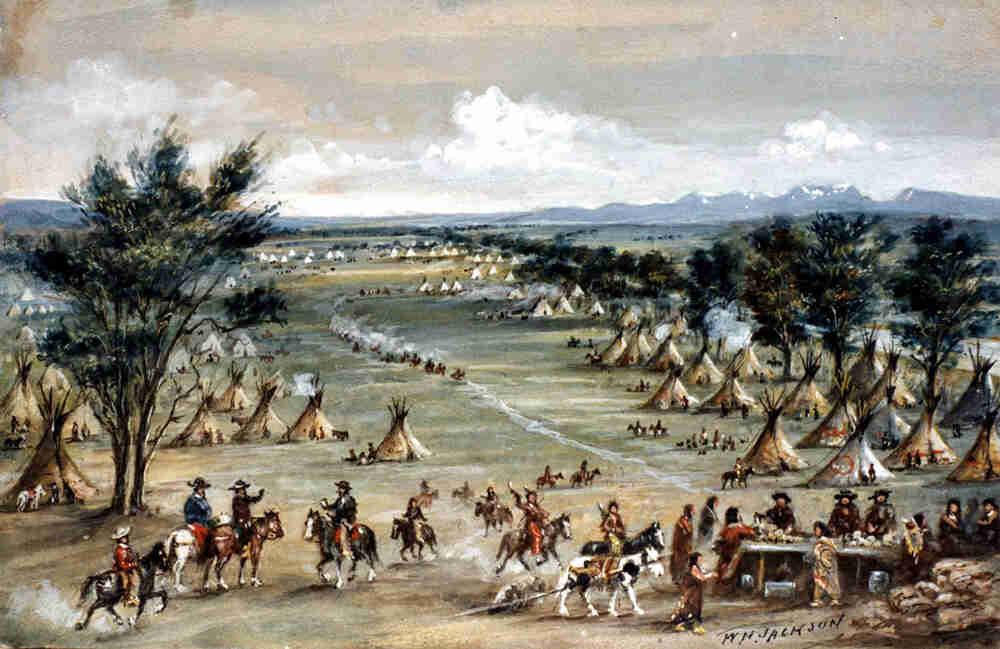Fort Davy Crockett
Full Article
Fort Davy Crockett was one of three known nineteenth-century forts and trading posts on the western side of the Rocky Mountains, in the drainage systems of the Green and Colorado Rivers. From the mid-1830s to 1840, Fort Davy Crockett, along with Fort Uncompahgre and Fort Uintah, served as centers of trade with Native American tribes, fur trappers, and passing travelers. Prior to the establishment of Fort Davy Crockett, the location was an important wintering spot for Native Americans and early fur trappers. Once established, the fort would become an important trade hub, social center, and crossroads linking the northern and southern frontiers.
The exact date of Fort Davy Crockett’s construction is unknown; however, several accounts suggest its origin sometime in the mid-1830s. The fort was established along the Green River in the far northwest corner of what became Colorado, within a naturally sheltered area referred to as Brown’s Hole. Brown’s Hole is just over eight miles long and is surrounded by upland landforms that shelter it from winter snows. Prior to the establishment of the fort, the area was a favored wintering and trade spot frequented by European fur trappers and Native American tribes such as Shoshones and Utes.
Trapper William Ashley gave the first description of the area in 1825. Following this, the Colonel Bean Party of Arkansas Trappers spent the winter of 1831–32 at Brown’s Hole. As the location became better known, partners William Craig, Philip Thompson, and Prewett (aka Pruett or Previtt) Sinclair—the three men originally part of the Bean Party—built a post at Brown’s Hole. By 1836 the post was known as Fort Davy Crockett, named after the Texas hero killed at the Alamo.
Much of what is known of the fort has been garnered through historical accounts from visitors passing through the area on established trails. One of the best accounts is given by Thomas Jefferson Farnham, leader of an Oregon-bound party in 1839. Farnham described the fort as “a hollow square of one-story log cabins with roofs and floors of mud.” Less than a week later, Dr. F. A. Wislizenus, a German doctor passing through the area, painted a dismal picture of the fort when he stated “the fort itself is the worst thing of the kind that we have seen on our journey . . . in short, the whole establishment appeared somewhat poverty-stricken.” The doctor’s account goes on to state that the fort was commonly known as Fort Misery (Fort de Misere) by local trappers.
The fort operated into 1840 when Christopher “Kit” Carson served as one of a band of hunters for the fort. In that same year, the last trade rendezvous occurred north of Brown’s Hole along the upper Green River, signaling the end of the fur trade era. The closing of the fort was precipitated by an incident involving one of the fort owners, Philip Thompson, in which horses were stolen from Fort Hall and from Indian allies. Thompson’s compatriots, unwilling to condone his actions, ultimately brought about the dissolution of the fort’s partnership between Thompson, Craig, and Sinclair. Although there were documented trading events in Brown’s Hole, the fort was no longer inhabited when John C. Frémont passed through Brown’s Hole in 1844 during his second western expedition. Frémont wrote that he camped across the river from “the remains of an old fort.” Considering that Frémont was accompanied by Kit Carson, the “old fort” was undoubtedly Fort Davy Crockett.
The fort was again mentioned by Captain Randolph B. Marcy as he trekked along the Green River during his near-fatal winter expedition over the Rocky Mountains in 1857. Marcy knew of the fort and stated that “Fort Davy Crockett was now in ruins, its crumbling walls presenting mute evidence of the passing of the hectic days of the fur trade.”



























